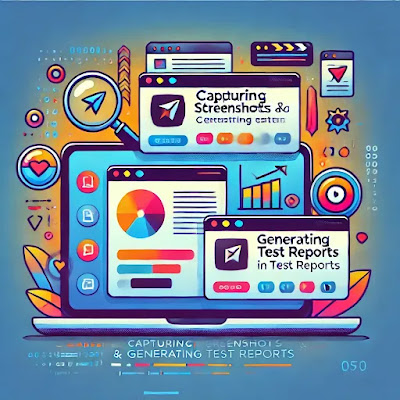Capturing Screenshots and Generating Test Reports in Playwright
Capturing Screenshots and Generating Test Reports in Playwright
Playwright is a powerful tool for automating end-to-end tests, but it also offers essential features for capturing screenshots and generating detailed test reports. These features are crucial for debugging, monitoring, and ensuring your web application functions correctly across different platforms and browsers.
In this article, we’ll explore how to capture screenshots and generate test reports in Playwright, focusing on practical examples that will help developers and testers create reliable, automated test suites.
Why Capture Screenshots and Generate Test Reports?
When running automated tests, capturing screenshots and generating reports can significantly enhance the testing process. Here are the key benefits:
- Debugging: Screenshots provide a visual context for test failures, making it easier to identify and fix bugs.
- Monitoring: Test reports provide a comprehensive overview of test results, allowing you to track application performance and stability over time.
- CI/CD Integration: Screenshots and reports can be automatically generated and integrated into your continuous integration pipeline, ensuring real-time visibility of test outcomes.
Capturing Screenshots with Playwright
Capturing screenshots in Playwright is straightforward and can be done at any point in your test flow. You can capture a screenshot of the entire page, a specific element, or during a test failure.
1. Capturing a Full Page Screenshot
Here’s how to capture a full-page screenshot in Playwright:
const { chromium } = require('playwright');
(async () => {
const browser = await chromium.launch();
const page = await browser.newPage();
await page.goto('https://example.com');
// Capture screenshot of the entire page
await page.screenshot({ path: 'fullpage_screenshot.png' });
await browser.close();
})();
In this example, Playwright navigates to the specified URL and captures a screenshot of the entire page, saving it as a PNG file.
2. Capturing a Screenshot of a Specific Element
You can also capture a screenshot of a specific element on the page, which can be useful when you want to focus on a particular UI component:
const { chromium } = require('playwright');
(async () => {
const browser = await chromium.launch();
const page = await browser.newPage();
await page.goto('https://example.com');
// Capture screenshot of a specific element
const element = await page.$('h1');
await element.screenshot({ path: 'element_screenshot.png' });
await browser.close();
})();
This script captures only the selected element (in this case, the page’s main heading) and saves it as a separate image file.
3. Capturing Screenshots on Test Failures
To assist in debugging failed tests, Playwright can automatically capture screenshots when a test fails. This is especially useful in continuous integration environments where visual evidence of failures is essential.
const { test, expect } = require('@playwright/test');
test('example test with failure screenshot', async ({ page }) => {
await page.goto('https://example.com');
try {
await expect(page).toHaveTitle('Nonexistent Title');
} catch (error) {
// Capture screenshot on failure
await page.screenshot({ path: 'failure_screenshot.png' });
throw error;
}
});
In this example, a screenshot will be captured when the test fails, and the image can be referenced later for debugging.
Generating Test Reports in Playwright
Playwright’s reporting capabilities help you analyze the results of your tests in detail. With built-in reporters and custom reporting options, you can easily integrate reports into your test suite.
1. Using the Built-in HTML Reporter
Playwright comes with an HTML reporter that generates a visually rich report of your test results. You can enable it by adding the following configuration:
{
"reporters": [
["html", { "outputFolder": "playwright-report" }]
]
}
Once the tests have been executed, you can open the generated report in any browser to see detailed insights, including test steps, screenshots, and failure logs.
2. Custom Reporters in Playwright
In addition to the built-in reporters, Playwright allows you to create custom reporters that fit your specific reporting needs. You can create a custom reporter using Node.js and integrate it into your test framework. Here's a simple example of a custom JSON reporter:
const fs = require('fs');
class MyJsonReporter {
onBegin(config, suite) {
console.log(`Starting the run with ${suite.allTests().length} tests.`);
}
onTestEnd(test, result) {
fs.writeFileSync('test-results.json', JSON.stringify({
title: test.title,
status: result.status,
}, null, 2));
}
onEnd(result) {
console.log(`Finished the run: ${result.status}`);
}
}
module.exports = MyJsonReporter;
This reporter logs test results into a JSON file, which can then be used for further analysis or integration with other tools.
Best Practices for Screenshot and Report Management
Managing screenshots and test reports effectively is crucial for maintaining a reliable test suite. Here are some best practices:
- Organize Screenshots: Save screenshots in organized directories, especially when running multiple tests, to avoid clutter.
- Capture Screenshots Selectively: Capture screenshots only when necessary (e.g., on test failures) to optimize test execution speed.
- Use Version Control for Reports: Store test reports in version control (e.g., Git) to track changes in test results over time.
- Integrate with CI/CD: Ensure that screenshots and reports are integrated into your CI/CD pipeline for real-time test feedback.
Conclusion
Capturing screenshots and generating test reports are essential steps in the testing process. Playwright makes it easy to automate these tasks, providing valuable insights into test outcomes and making debugging more efficient. By integrating these features into your test suite, you can ensure that your application remains reliable, user-friendly, and free of bugs.
Follow the steps outlined in this guide to implement screenshots and test reports in Playwright, and take your test automation to the next level.



Comments
Post a Comment